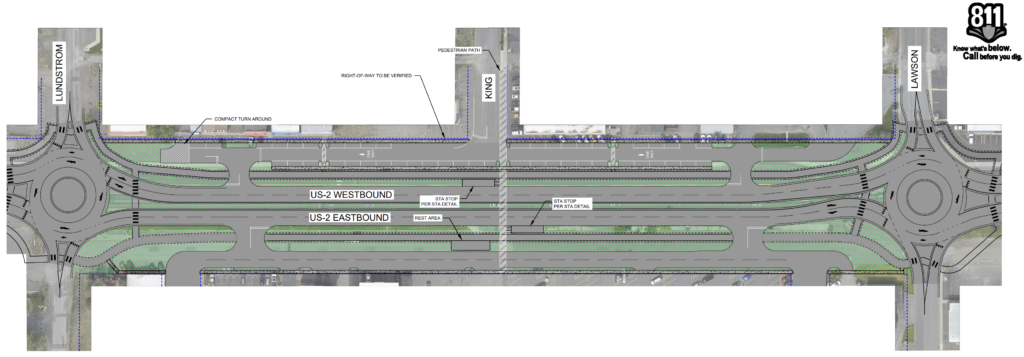Airway Heights is set to undergo a major transformation through the U.S. Highway 2 Pedestrian Safety Improvement Project. Led by city planners, community members, and stakeholders, this ambitious initiative aims to enhance safety for pedestrians and cyclists while fostering a sense of community. Divided into two phases, the project will focus on improving the segment from Lawson to Lundstrom and from Craig Road to Garfield Road.
The project’s primary objective is to incorporate various transportation options, such as walking, biking, rolling, and transit, for the daily fabric of Airway Heights. Safety and accessibility for all community members are the top priorities.
Community input has been important to the project’s planning stages, with insights drawn from the 2017 U.S. 2 Corridor Plan and the 2021 Downtown Plan. Crafted through extensive community engagement, these plans reflect the community’s goals for a traditional downtown experience characterized by small businesses, a cozy small-town ambiance, and a pedestrian-friendly environment.
“Based on community input they felt that it was their traditional downtown,” Heather Trautman, Principal Planner for the City of Airway Heights on this project explains how the corridor was chosen. “They really liked the small-town feel. They wanted smaller businesses that focused on services that are unique.”
To create a vibrant and accessible downtown core, the project proposes essential measures. These include reducing speed limits from 35 to 25mph, incorporating green spaces, implementing pedestrian crossings with advanced signaling systems, and ensuring continuous sidewalks along storefronts. By thoughtfully blending greenery, public art, and urban design elements, the project aims to cultivate a welcoming downtown atmosphere that encourages residents and visitors to explore and connect.
The project intends to address automobile dependency by maintaining current traffic lanes while prioritizing safety and access across the corridor. Key strategies include redesigning crossings and integrating multimodal paths to bridge residential areas with essential city services. The goal is to reduce reliance on cars and encourage alternative modes of transportation. The project team has been working closely with the Spokane Transit Authority to decide on the best position for the bus stops.
As the project moves forward after just reaching a 30% completion milestone in February, there will still be opportunities for public input and refinement as the design and planning reaches the next milestone. This process ensures that the evolving design remains responsive to the community’s needs. Feedback will cover aspects ranging from pedestrian safety enhancements to functional and aesthetic improvements to the public areas.

The project is scheduled to complete the planning, engineering, and design phases for both Phase 1 and Phase 2 by June. This progress sets the stage for securing construction funding, emphasizing the collaborative effort required to achieve transformative urban development. Federal and state grants will play a crucial role in bringing this project to fruition.
“Projects are broken up into what’s called planning, engineering, and design. And then the second part is construction. The grants we received were for planning, engineering, and design, and that will be complete in June of this year.” Trautman and her team are looking past the completion of part one. “We’re already working on what comes after that, which is for construction money. Public projects are funded predominantly through federal grants and state grants. Most projects require grant funding because local dollars are received through property taxes and sales tax are not enough.”
Embracing sustainability and environmental considerations, the project includes measures like drought-resistant plantings and the use of reclaimed water for irrigation. These actions align with broader goals of enhancing urban resilience and promoting sustainable community development.
In addition to community feedback during planning stages, the U.S. Highway 2 Pedestrian Safety Improvement Project provides opportunities for ongoing community input. Heather Trautman provided information about upcoming meetings and events designed to engage the community. The next meeting is scheduled for March 25th, divided into two parts: 11:30 AM to 1:30 PM at the Hub on US 2 and 4:30 PM to 6:30 PM at the Airway Heights Recreation Center. The project will also participate in a joint community engagement event with Spokane Transit Authority at the Norway Heights library on March 28th from 4 PM to 6 PM, along with other community partners. More events are planned for April, May, and June, and the project website, as well as the City of Airway Heights’ Facebook page, will provide information on these upcoming events.
“We invite people to take a turn, go through Airway Heights, and see what it has to offer,” Trautman encourages everyone, not just local residents to experience Airway Heights, “with regards to residential areas, parks and other services. And even Highway 2, since it is a big part of the community.” The U.S. Highway 2 Pedestrian Safety Improvement Project aims to make Airway Heights safer, more connected, and vibrant. By transforming the main thoroughfare, the city will create growth, safety, and inclusivity, while fostering community pride and belonging. This project will enhance pedestrian and cyclist safety, creating a renewed sense of place that reflects Airway Heights community’s values and aspirations for a thriving future.



